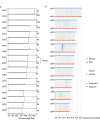Haplotype-resolved chromosomal-level genome assembly of Buzhaye (Microcos paniculata)
- PMID: 38102170
- PMCID: PMC10724166
- DOI: 10.1038/s41597-023-02821-9
Haplotype-resolved chromosomal-level genome assembly of Buzhaye (Microcos paniculata)
Abstract
Microcos paniculata is a shrub used traditionally as folk medicine and to make herbal teas. Previous research into this species has mainly focused on its chemical composition and medicinal value. However, the lack of a reference genome limits the study of the molecular mechanisms of active compounds in this species. Here, we assembled a haplotype-resolved chromosome-level genome of M. paniculata based on PacBio HiFi and Hi-C data. The assembly contains two haploid genomes with sizes 399.43 Mb and 393.10 Mb, with contig N50 lengths of 43.44 Mb and 30.17 Mb, respectively. About 99.93% of the assembled sequences could be anchored to 18 pseudo-chromosomes. Additionally, a total of 482 Mb repeat sequences were identified, accounting for 60.76% of the genome. A total of 49,439 protein-coding genes were identified, of which 48,979 (99%) were functionally annotated. This haplotype-resolved chromosome-level assembly and annotation of M. paniculata will serve as a valuable resource for investigating the biosynthesis and genetic basis of active compounds in this species, as well as advancing evolutionary phylogenomic studies in Malvales.
© 2023. The Author(s).
Conflict of interest statement
The authors declare no competing interests.
Figures





Similar articles
-
Haplotype-resolved genome assembly of Coriaria nepalensis a non-legume nitrogen-fixing shrub.Sci Data. 2023 May 9;10(1):259. doi: 10.1038/s41597-023-02171-6. Sci Data. 2023. PMID: 37156769 Free PMC article.
-
An chromosome-level haplotype-resolved genome assembly and annotation of pitaya (Selenicereus polyrhizus).Sci Data. 2025 Apr 1;12(1):549. doi: 10.1038/s41597-025-04678-6. Sci Data. 2025. PMID: 40169608 Free PMC article.
-
Chromosome-level genome assembly and annotation of Flueggea virosa (Phyllanthaceae).Sci Data. 2024 Aug 13;11(1):875. doi: 10.1038/s41597-024-03681-7. Sci Data. 2024. PMID: 39138223 Free PMC article.
-
Chromosome-level haplotype-resolved genome assembly for Takifugu ocellatus using PacBio and Hi-C technologies.Sci Data. 2023 Jan 11;10(1):22. doi: 10.1038/s41597-023-01937-2. Sci Data. 2023. PMID: 36631464 Free PMC article.
-
A haplotype-resolved genome assembly of Rhododendron vialii based on PacBio HiFi reads and Hi-C data.Sci Data. 2023 Jul 12;10(1):451. doi: 10.1038/s41597-023-02362-1. Sci Data. 2023. PMID: 37438373 Free PMC article.
Cited by
-
Chromosome-scale haploid genome assembly of Durio zibethinus KanYao.Sci Data. 2025 Mar 5;12(1):384. doi: 10.1038/s41597-025-04656-y. Sci Data. 2025. PMID: 40044694 Free PMC article.
-
Reticulate allopolyploidy and subsequent dysploidy drive evolution and diversification in the cotton family.Nat Commun. 2025 Aug 12;16(1):7480. doi: 10.1038/s41467-025-62644-7. Nat Commun. 2025. PMID: 40796551 Free PMC article.
References
-
- National Medical Products Administration & National Health Commission of the People’s Republic of China. Pharmacopoeia of the People’s Republic of China Vol. 1 (China Medical Science Press, 2020).
-
- Yang Y, Li SG, Ye WC, Jiang RW. Studies on chemical constituents of Microcos paniculata. Lishizhen Medicine and Materia Medica Research. 2010;21:2790–2792.
-
- Lin, S. Transcriptomic sequencing of Microcos paniculata and the excavation of key genes in ACGs biosynthesis. Master thesis, Guangdong Pharmaceutical University (2017).
Publication types
MeSH terms
LinkOut - more resources
Full Text Sources
Miscellaneous

